Oral cancer, a subset of head and neck cancers, affects the mouth and throat. Oral cancer is characterised by the growth of malignant cells in the tissues of the oral cavity. Early detection is crucial as the prognosis improves significantly with prompt treatment. Risk factors include tobacco use, heavy alcohol consumption, and HPV infection. Regular dental check-ups and awareness of symptoms aid in early diagnosis.
Oral cancer presents various symptoms that go unnoticed in the early stages. Common symptoms include persistent sores or ulcers in the mouth, unexplained bleeding, and patches of red or white lesions on the gums, tongue, or mouth lining. Other signs involve difficulty chewing or swallowing, a persistent sore throat, and voice changes. Swelling or lumps in the neck and unexplained weight loss indicate the disease. Identifying these symptoms early leads to more effective treatment.
The treatment of oral cancer depends on the stage and location of the tumour. Surgical removal of the tumour is the first line of treatment, followed by radiation therapy to eliminate any remaining cancer cells. Chemotherapy is recommended for advanced stages or when the cancer has spread to other parts of the body. Targeted therapy focuses on specific molecules involved in cancer growth, and immunotherapy, which boosts the body's immune system to fight cancer, is an emerging treatment option. A multidisciplinary approach involving surgeons, oncologists, and radiologists is essential for optimal patient care.
Several factors contribute to the development of oral cancer, such as tobacco use, heavy alcohol consumption, and human papillomavirus. Tobacco use is the leading cause, including smoking and smokeless tobacco. Heavy alcohol consumption increases the risk when combined with tobacco use. Human papillomavirus (HPV) infection, particularly HPV-16, is a major cause. Other risk factors include excessive sun exposure to the lips, a diet low in fruits and vegetables, and a family history of cancer. Understanding these causes helps in the prevention and early detection of oral cancer.
Oral cancer shares symptoms with several other conditions, making differential diagnosis essential. Conditions such as oral thrush, leukoplakia, and erythroplakia present with similar lesions in the mouth. Oral lichen planus and chronic mechanical trauma from dental appliances mimic the symptoms of oral cancer. Distinguishing these conditions through clinical evaluation and biopsy is crucial to ensure accurate diagnosis and appropriate treatment.
Recent research in oral cancer focuses on improving diagnostic techniques, exploring new treatment modalities, and understanding the molecular mechanisms of the disease. Notable researchers in this field include Dr. Maura Gillison, known for her work on HPV-related head and neck cancers, and Dr. John Minna, who has contributed significantly to understanding the genetic basis of cancer. Studies are ongoing to develop better screening tools and personalised therapies to enhance patient outcomes. Research institutions like the National Cancer Institute and the American Association for Cancer Research are at the forefront of these efforts.
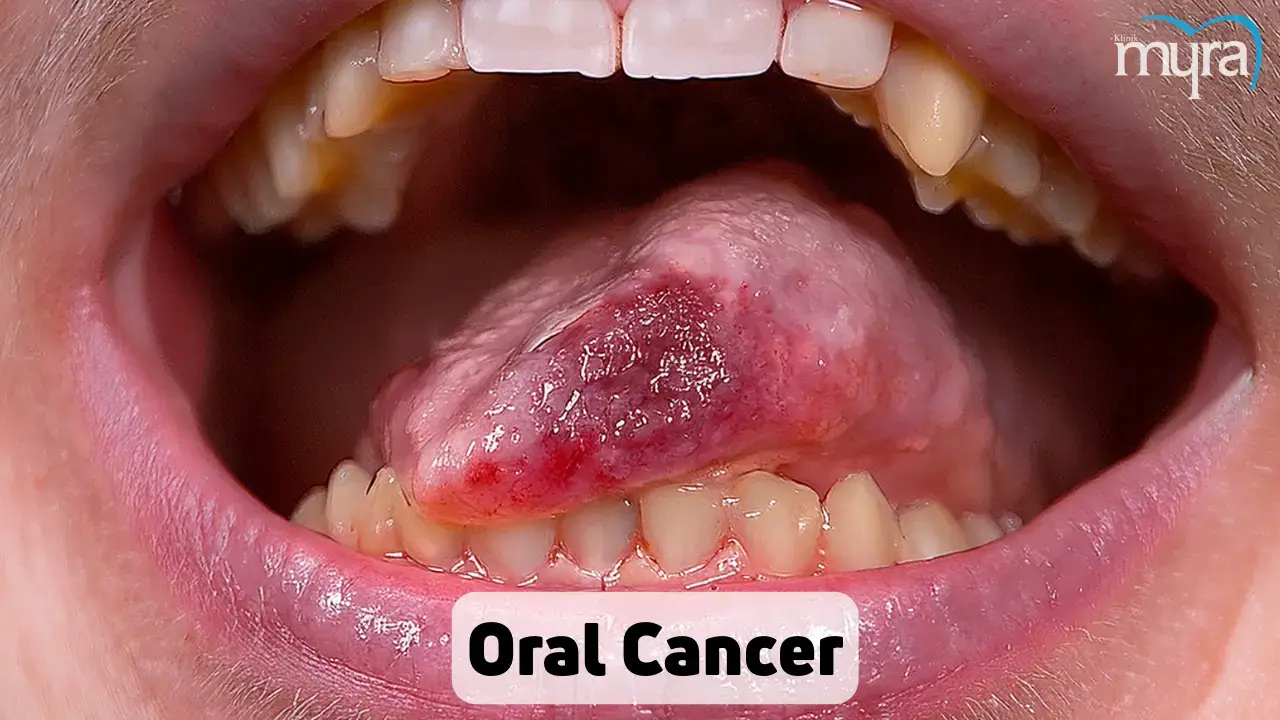
What are the Types of Oral Cancer?
The Types of Oral Cancer are listed below.
- Squamous Cell Carcinoma: Squamous cell carcinoma is a common type of oral cancer, accounting for more than 90% of cases. It originates in the squamous cells that line the mouth, tongue, and lips. These cancers present as red or white patches, ulcers, or growths that do not heal.
- Verrucous Carcinoma: Verrucous carcinoma is a rare, slow-growing type of cancer that affects the gums, cheeks, and floor of the mouth. It appears as a thick, warty growth and is less likely to spread to other parts of the body than other oral cancer types.
- Minor Salivary Gland Carcinomas: Minor salivary gland carcinomas originate in the small salivary glands found throughout the mouth and throat lining. Types include adenoid cystic carcinoma, mucoepidermoid carcinoma, and polymorphous low-grade adenocarcinoma. These cancers vary greatly in behaviour and prognosis.
- Lymphomas: Lymphomas are cancers that start in the lymphatic system but occur in the mouth, the tonsils or the base of the tongue. The two main types are Hodgkin lymphoma and non-Hodgkin lymphoma.
- Melanoma: Oral melanoma is a rare type of cancer that develops from the pigment-producing cells (melanocytes) in the mucous membrane of the mouth. It appears as a dark, irregularly shaped lesion and is more aggressive than other types of oral cancer.
- Sarcomas: Sarcomas are cancers that originate in the bone, cartilage, muscle, or other connective tissues. Osteosarcomas (bone) and chondrosarcomas (cartilage) occur in the oral cavity. These cancers are relatively rare but quite aggressive.
- Basal Cell Carcinoma: Basal cell carcinoma occasionally affects the lips, although it is commonly associated with skin cancer. The type of cancer tends to be slow-growing and is less likely to spread to other parts of the body.
- Oral Kaposi Sarcoma: Kaposi sarcoma is a cancer that develops from the cells lining lymph or blood vessels. It appears as red, purple, or brown lesions on the gums, tongue, or mucous membranes. Cancer is more common in individuals with weakened immune systems, such as those with HIV/AIDS.
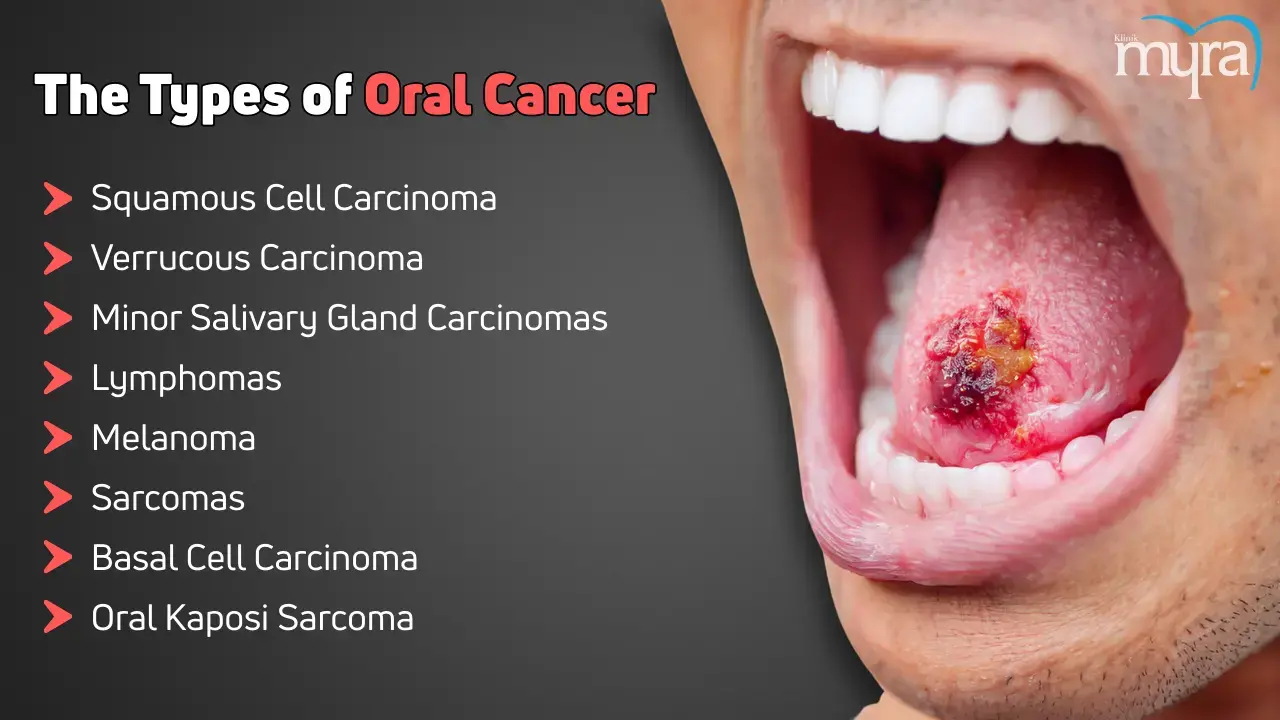
What are the Symptoms of Oral Cancer?
The Symptoms of Oral Cancer are listed below.
- Persistent Sores: The most common symptom is a sore in the mouth that does not heal within two weeks. These sores are found on the lips, gums, tongue, or inside the cheeks and bleed easily.
- Red or White Patches: The appearance of red (erythroplakia) or white (leukoplakia) patches in the mouth is a significant warning sign. These patches are flat or slightly raised and are painless but persistent.
- Unexplained Bleeding: Unexplained bleeding in the mouth indicates oral cancer. The bleeding occurs without apparent cause, such as injury or irritation from dental appliances.
- Lump or Thickening: A noticeable lump or thickening in the cheek, gums, or other areas inside the mouth is a sign of oral cancer. These lumps are not painful initially but must be evaluated by a healthcare professional.
- Difficulty in Chewing or Swallowing: Oral cancer causes pain or difficulty when chewing, swallowing, or moving the jaw or tongue. It leads to changes in eating habits and unexplained weight loss.
- Persistent Sore Throat or Hoarseness: A chronic sore throat or a feeling that something is caught in the throat are symptoms of oral cancer. Hoarseness or changes in the voice that persist for more than two weeks must be investigated.
- Ear Pain: Pain in one ear without hearing loss is a symptom of oral cancer if it occurs in conjunction with other signs. The type of referred pain is due to the shared nerve pathways in the head and neck.
- Numbness or Pain: Persistent numbness or pain in the tongue, jaw, or other areas of the mouth indicates nerve involvement by a tumour. The symptom must prompt immediate medical evaluation.
- Changes in Dentures: Oral cancer causes changes in the fit of dentures or discomfort when wearing them. It is due to swelling or growths that alter the shape of the oral cavity.
- Bad Breath: Persistent bad breath (halitosis) that does not improve with oral hygiene measures is associated with oral cancer.
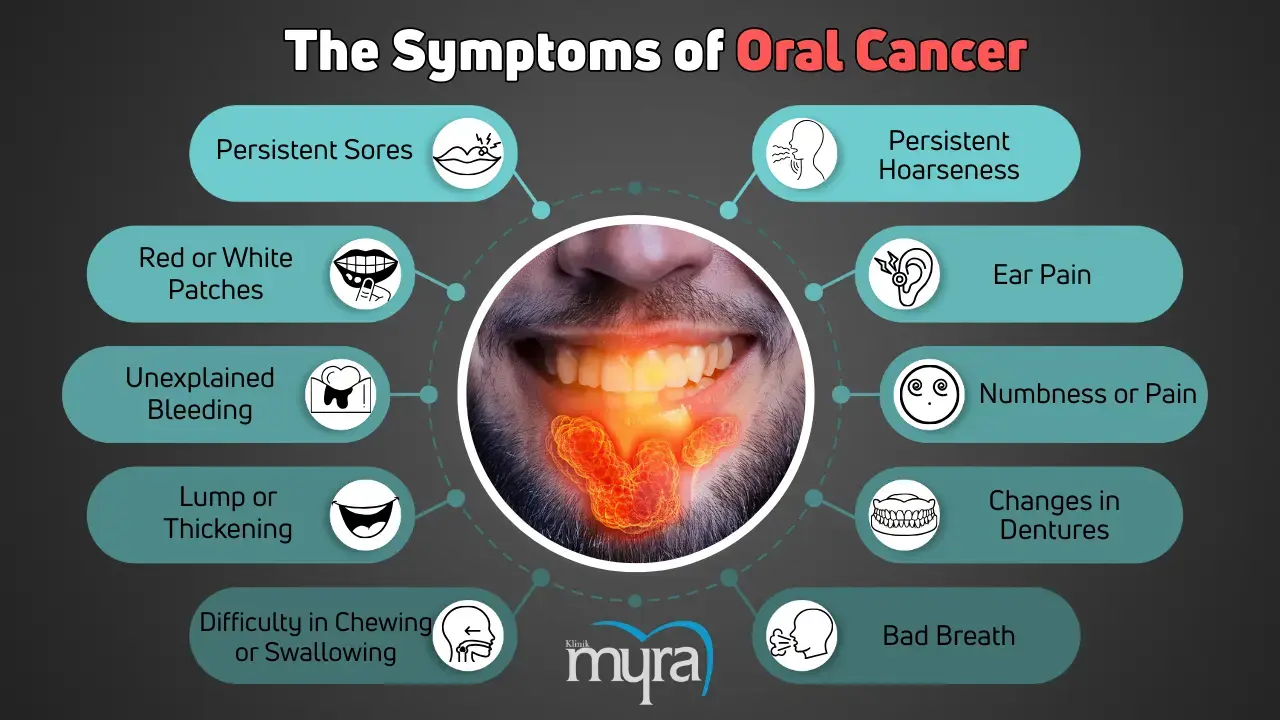
What are the Causes of Oral Cancer?
The Causes of Oral Cancer are listed below.
- Tobacco Use: Tobacco use is the leading cause of oral cancer, including smoking cigarettes, cigars, pipes and using smokeless tobacco like chewing tobacco and snuff. The carcinogenic chemicals in tobacco damage the DNA in cells of the mouth, leading to mutations and cancer.
- Alcohol Consumption: Heavy alcohol consumption is another significant risk factor for oral cancer. Alcohol irritates the cells in the mouth, making them more susceptible to the carcinogenic effects of tobacco. The risk is high in individuals who use tobacco and alcohol.
- Human Papillomavirus (HPV) Infection: HPV, particularly the HPV-16 strain, is a major cause of oropharyngeal cancers, which affect the base of the tongue, tonsils, and the back of the throat. HPV is a sexually transmitted virus, and its association with oral cancer has been increasing in recent years.
- Excessive Sun Exposure: Prolonged exposure to ultraviolet (UV) radiation from the sun increases the risk of cancer on the lips. People who work outdoors or spend much time in the sun without proper lip protection are at higher risk.
- Diet and Nutrition: A diet low in fruits and vegetables contributes to the development of oral cancer. These foods contain antioxidants and other compounds that help protect cells from damage. A poor diet weakens the immune system, making it less effective at fighting off cancerous changes.
- Genetic Predisposition: A family history of cancer increases the risk of developing oral cancer. Certain genetic mutations that are inherited predispose individuals to various types of cancer, including people of the mouth and throat.
- Age and Gender: Oral cancer is more common in individuals over the age of 40 and is more prevalent in men than in women. It is due to higher rates of tobacco and alcohol use in men.
- Weakened Immune System: A weakened immune system, whether from certain medical conditions, medications, or infections like HIV/AIDS, increases the risk of oral cancer. The immune system plays a crucial role in detecting and destroying cancerous cells.
- Chronic Irritation: Chronic irritation from rough teeth, ill-fitting dentures, or other dental issues contribute to the development of oral cancer. Constant irritation causes cells to become dysplastic, which leads to cancer.
- Betel Quid and Areca Nut Chewing: Chewing betel quid and areca nut is a common risk factor for oral cancer in some cultures. These substances contain carcinogens that cause cellular changes in the mouth.
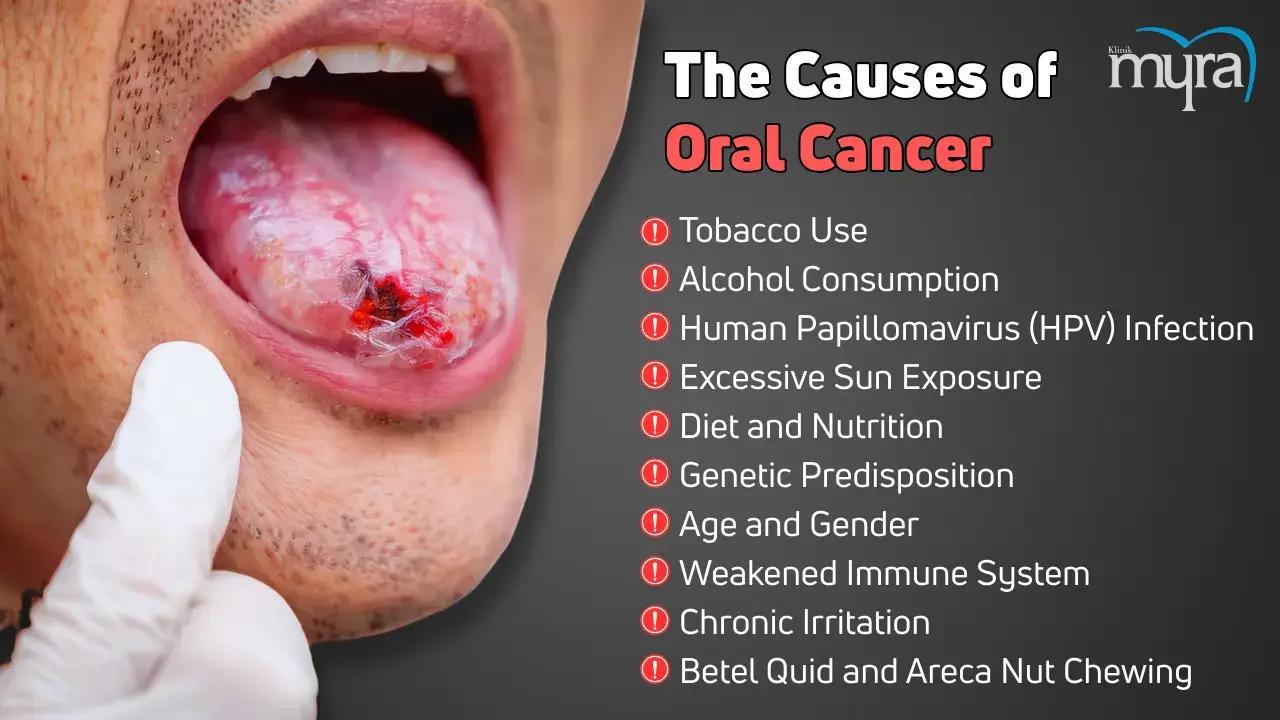
What are the Treatments for Oral Cancer?
The Treatments for Oral Cancer are listed below.
- Surgery: Surgery is a common treatment for oral cancer in the early stages. The goal is to remove the cancerous tumour and some surrounding healthy tissue to eliminate all cancer cells. Surgical procedures include tumour resection, mandibulectomy or maxillectomy, glossectomy, and neck dissection. Tumour Resection is removal of the tumour and a margin of surrounding tissue. Mandibulectomy or Maxillectomy is a partial or total jawbone removal if the cancer has spread to these areas. Glossectomy is partial or total tongue removal if the tumour is located there. Neck Dissection is the removal of lymph nodes in the neck if the cancer has spread.
- Radiation Therapy: Radiation therapy uses high-energy beams to kill cancer cells. It is used as a primary treatment or in combination with surgery and chemotherapy. Types of radiation therapy include external beam radiation therapy and brachytherapy. External Beam Radiation Therapy directs radiation outside the body to the cancerous area. Brachytherapy places radioactive material directly inside or near the tumour. Radiation therapy is used post-surgery to destroy any remaining cancer cells and reduce the risk of recurrence.
- Chemotherapy: Chemotherapy involves using drugs to kill cancer cells or stop them from growing. It is used in combination with radiation therapy, especially in advanced stages of oral cancer. Chemotherapy helps shrink tumours before surgery or address cancer that has spread to other parts of the body.
- Targeted Therapy: Targeted therapy uses drugs to target specific molecules involved in the growth and spread of cancer cells. These therapies interfere with cancer cell growth and help the immune system destroy cancer cells. Examples of targeted therapy drugs for oral cancer include cetuximab, which targets the epidermal growth factor receptor (EGFR).
- Immunotherapy: Immunotherapy boosts the body's immune system to fight cancer. It is effective for cancers that do not respond well to other treatments. Drugs such as pembrolizumab and nivolumab have shown promise in treating advanced oral cancers by targeting immune checkpoints.
- Reconstructive Surgery: Reconstructive surgery is necessary to restore function and appearance after a tumour is removed. It involves skin grafts, bone grafts, and prosthetic devices. Reconstructive surgery aims to improve the patient’s ability to eat, speak, and maintain a normal appearance.
- Rehabilitation and Supportive Care: Rehabilitation is essential to oral cancer treatment to help patients regain function and quality of life. It includes physical therapy, speech therapy, and nutritional support. Pain management and psychological support are critical components of comprehensive cancer care.
- Clinical Trials: Clinical trials offer patients access to new and experimental treatments that are not widely available. Participation in clinical trials provides additional options for patients, particularly patients with advanced or treatment-resistant cancer.
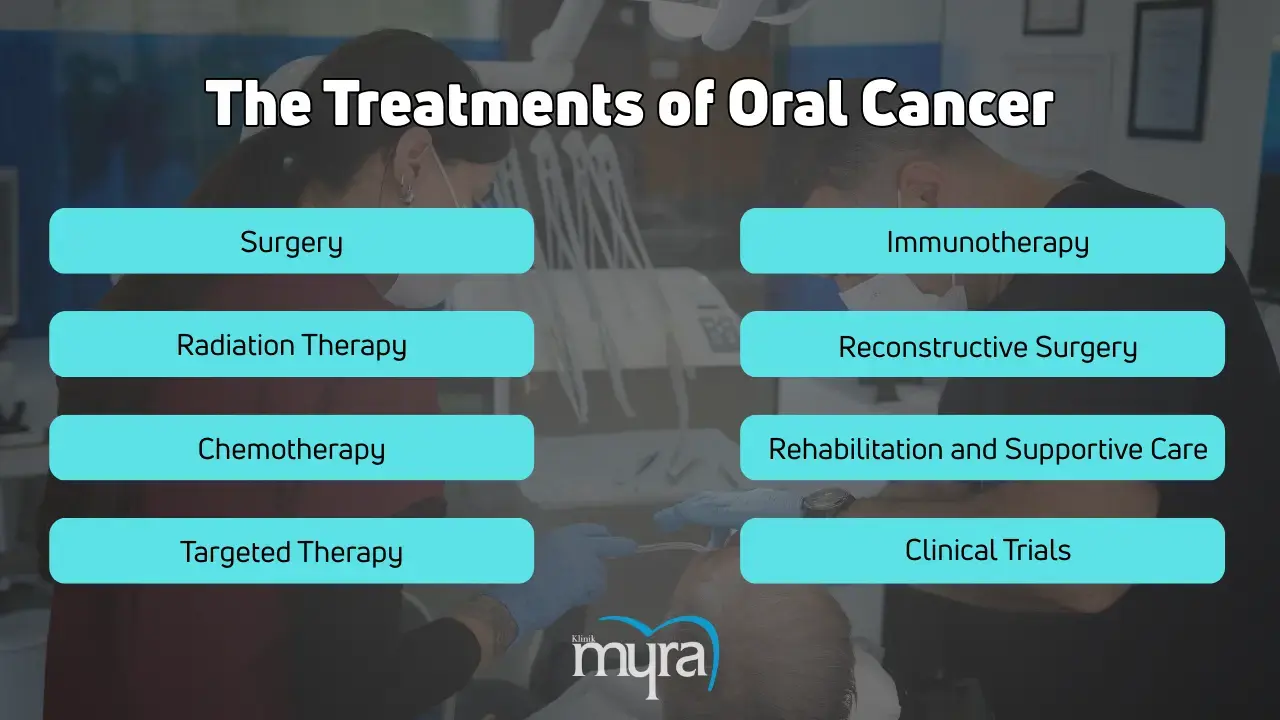
Can Oral Cancer Be Treated At Home?
No, oral cancer cannot be treated at home. Effective treatment of oral cancer requires professional medical intervention, including surgical procedures, radiation therapy, chemotherapy, targeted therapy, and immunotherapy. These treatments involve specialised equipment, medications, and expertise unavailable at home. Early detection and professional medical care are crucial for successful outcomes. Home care supports managing symptoms and side effects under healthcare professionals' guidance, but it does not replace standard medical treatments. Regular follow-ups and professional monitoring are essential to ensure effective treatment and promptly address complications.
What are the Researches about Oral Cancer?
The research about oral cancer spans various domains, focusing on understanding the disease's mechanisms, improving diagnostic techniques, and developing effective treatments. Multiple studies and research entities have contributed to the field, providing valuable insights and advancing clinical practices.
Studies have delved into the molecular mechanisms underlying oral cancer. Research by Dr. Maura Gillison has been pivotal in understanding the role of human papillomavirus (HPV) in oropharyngeal cancers, highlighting the HPV-16 strain as a significant risk factor. Another notable study by Dr. John Minna and colleagues at the University of Texas Southwestern Medical Center explored genetic mutations associated with oral cancer, identifying specific alterations in tumour suppressor genes like TP53 and oncogenes like EGFR. These findings help identify potential targets for new therapies.
Research efforts have focused on improving diagnostic methods for early detection of oral cancer. A study by the National Cancer Institute (NCI) evaluated the efficacy of salivary biomarkers in detecting oral cancer. The study demonstrated that specific protein and genetic markers in saliva are non-invasive diagnostic tools, providing a promising alternative to traditional biopsy methods. Advanced imaging techniques, such as fluorescence visualisation and narrowband imaging, have been investigated by researchers at the American Association for Cancer Research (AACR), showing enhanced accuracy in identifying malignant lesions.
Innovative therapeutic approaches constitute a significant focus of oral cancer research. The advent of targeted therapy has been an important breakthrough. A study by Dr. Ezra Cohen at the University of California, San Diego, examined the efficacy of cetuximab, a targeted therapy drug that inhibits EGFR, in treating advanced oral cancer. The results showed improved survival rates and reduced side effects compared to traditional chemotherapy. Immunotherapy is another promising area, with research by Dr. Antoni Ribas at UCLA demonstrating the effectiveness of immune checkpoint inhibitors like pembrolizumab and nivolumab in enhancing the body's immune response against cancer cells.
Numerous clinical trials are underway to explore new treatment options for oral cancer. The Oral Cancer Foundation has been instrumental in funding and facilitating these trials. A trial conducted at the Dana-Farber Cancer Institute investigates combining immunotherapy with traditional treatments like radiation and chemotherapy. Preliminary results indicate that the combination significantly enhances treatment efficacy and reduces recurrence rates.
Public health research is crucial in understanding the epidemiology of oral cancer and developing preventive strategies. The World Health Organization (WHO) has conducted extensive studies on the impact of tobacco and alcohol consumption on oral cancer incidence. These studies provide robust evidence linking these lifestyle factors to higher cancer risk, underscoring the importance of public health campaigns aimed at reducing tobacco use and promoting healthy behaviours.
Inflammation, bleeding, or persistent sores in your gums could signal serious conditions, including oral cancer. Regular dental visits ensure early detection and effective management of gum problems.
Research continues to provide deeper insights into the aetiology, diagnosis, and treatment of oral cancer. Collaborative efforts between academic institutions, research entities, and healthcare organisations are vital in advancing our understanding and improving patient outcomes. The future holds promise for more effective and less invasive treatments for oral cancer with continued research and innovation.

What are the Differences between Oral Cancer and Mouth Sores?
The differences between oral cancer and mouth sores are through their causes, symptoms, treatments, and outcomes. Understanding these differences is crucial for proper diagnosis and management. Oral cancer is caused by long-term exposure to risk factors such as tobacco use, heavy alcohol consumption, human papillomavirus (HPV) infection, excessive sun exposure to the lips, and genetic predisposition. It involves the uncontrolled growth of malignant cells in the mouth or throat tissues. Mouth sores arise from a variety of less severe causes. Common mouth sores include canker sores (aphthous ulcers), triggered by stress, minor oral trauma, hormonal changes, or vitamin deficiencies such as B12 and iron. Other mouth sores include cold sores caused by the herpes simplex virus and sores resulting from irritation due to dental appliances or sharp teeth.
Oral cancer presents with persistent symptoms such as non-healing sores, lumps or thickening in the mouth or throat, red or white patches, unexplained bleeding, and difficulty in chewing or swallowing. Pain, numbness, or a persistent sore throat are indicative of oral cancer. Treatment for oral cancer involves a combination of surgery to remove the tumour, radiation therapy to destroy remaining cancer cells, and chemotherapy to target cancer cells throughout the body. Advanced cases benefit from targeted therapy or immunotherapy.
Mouth sores are less serious and present as small, painful ulcers in the mouth. Canker sores are round with a white or yellow centre and a red border, while cold sores appear as clusters of blisters that burst and crust over. Treatment for mouth sores is supportive, focusing on pain relief and promoting healing. Over-the-counter topical medications, saltwater rinses, and avoiding spicy or acidic foods help manage symptoms. Antiviral medications are prescribed for severe or recurrent cold sores.
Oral cancer and mouth sores share some similarities despite their differences. Oral cancer and mouth sores cause discomfort and pain in the oral cavity, and initially present as sores or lesions in the mouth. These conditions affect an individual's ability to eat, speak, and maintain oral hygiene, decreasing quality of life.
Regular dental check-ups are important for oral cancer and mouth sores. A dental professional provides advice on managing and preventing outbreaks of mouth sores. Regular check-ups aid in early detection, improving treatment outcomes for oral cancer. Oral cancer and mouth sores highlight the importance of maintaining good oral hygiene and being attentive to any changes or persistent symptoms in the mouth.
Oral cancer and mouth sores are distinct conditions with different causes, symptoms, and treatments. Oral cancer is a serious, life-threatening condition requiring medical intervention, while mouth sores are benign and self-limiting. Understanding the differences and similarities between these conditions is essential for appropriate diagnosis and management, ensuring individuals receive the necessary care and intervention.






